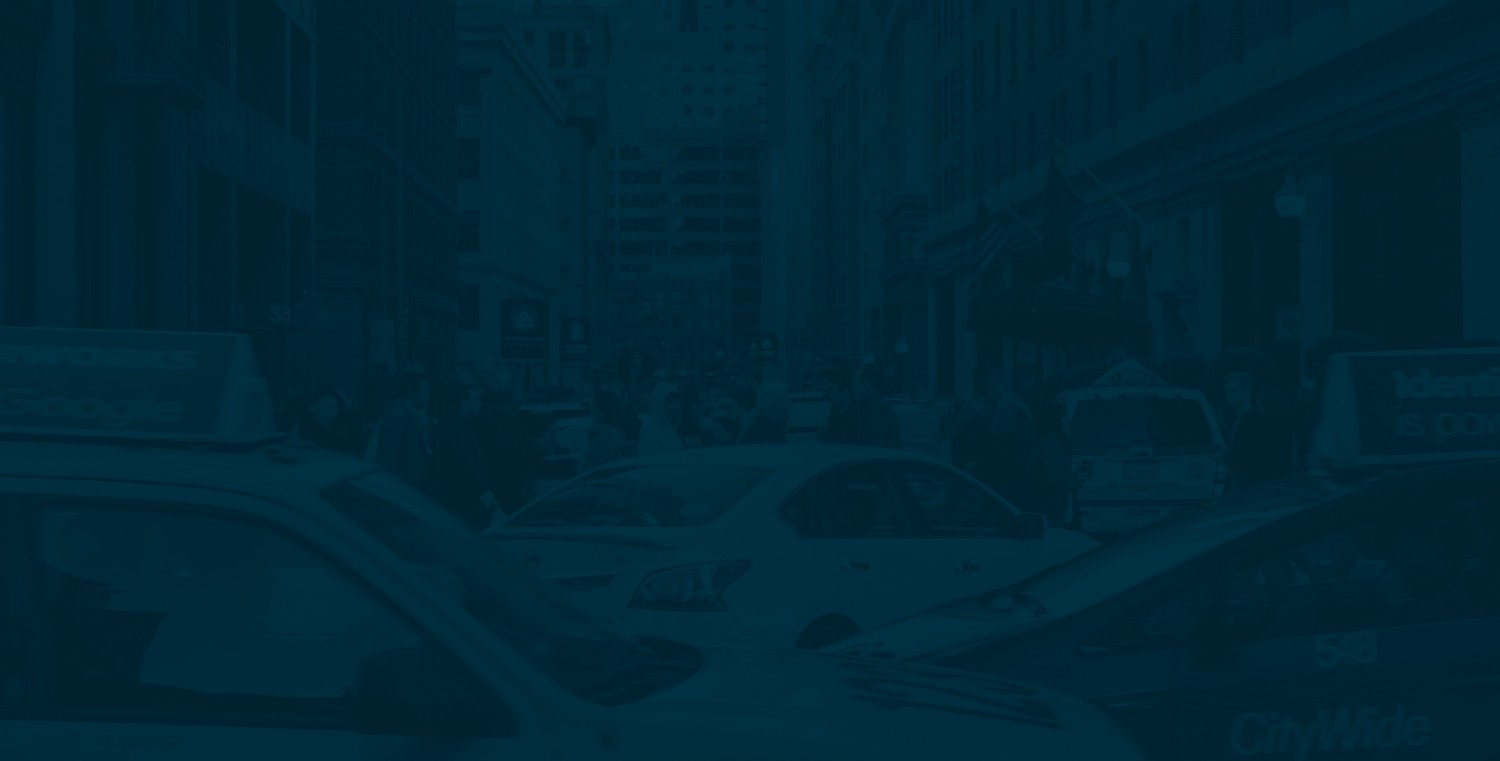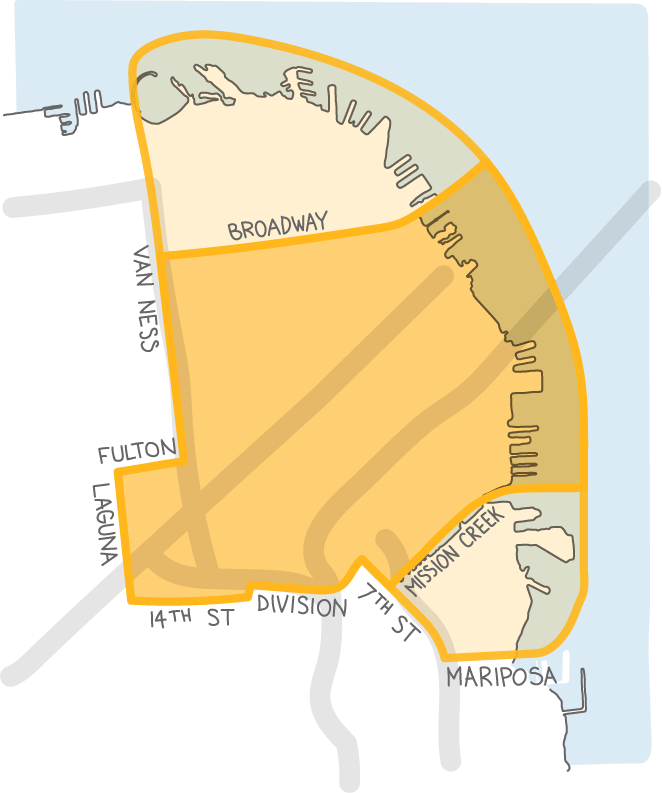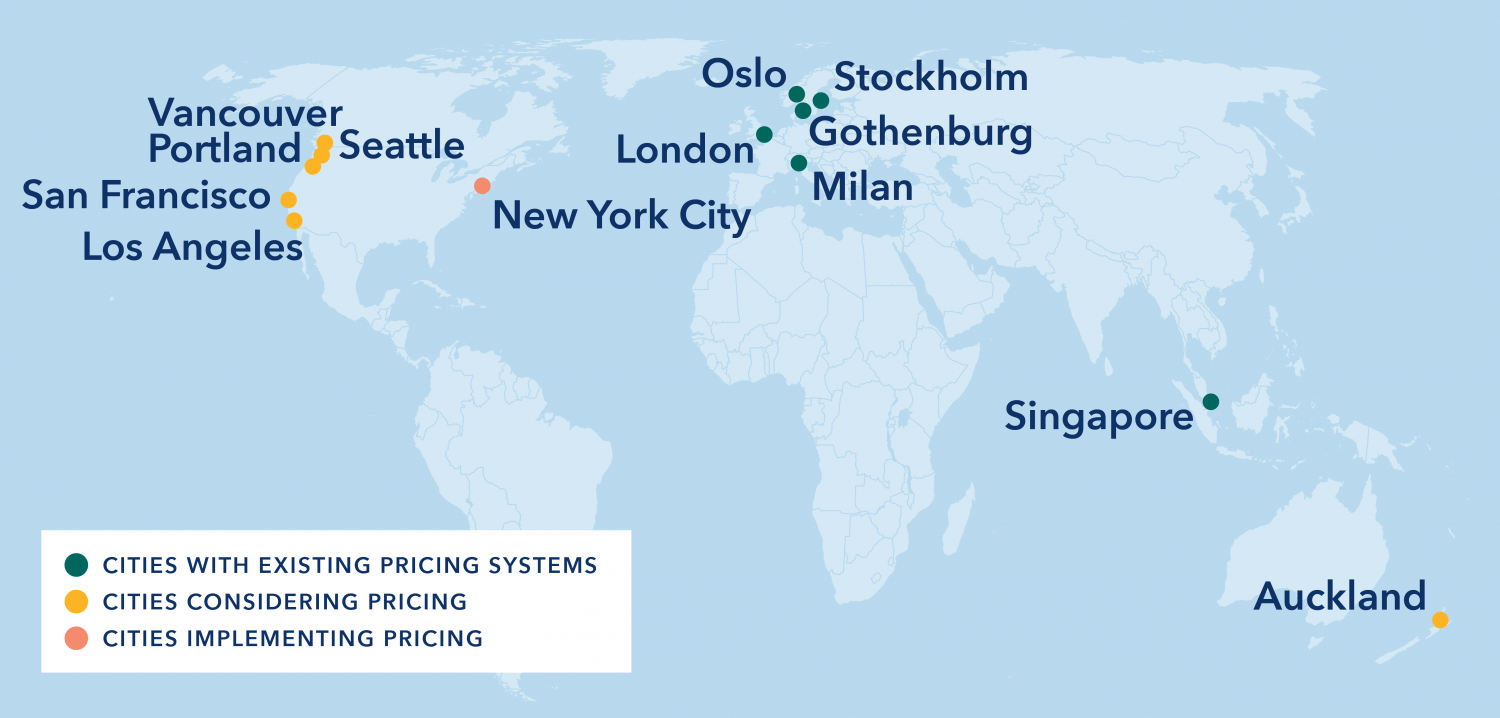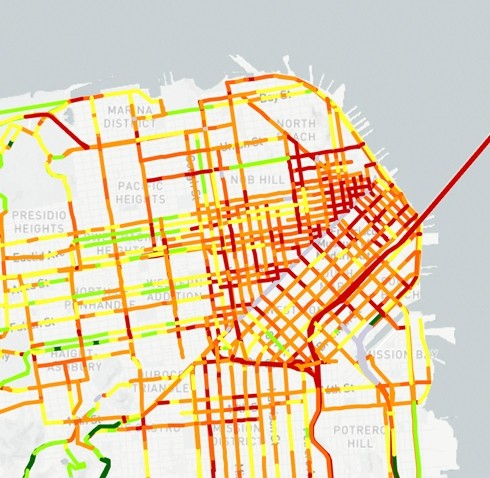Stay Updated
The Transportation Authority has paused the study.
Sign up below to get email updates once the study resumes.
Studying Congestion Pricing to Prepare for the Future
Congestion pricing involves charging drivers a fee to drive into congested areas of northeast San Francisco during rush hours. Program revenue could be used to improve transit service. Congestion pricing would not be implemented immediately—it would take at least five years to plan and implement a congestion pricing program.
The Transportation Authority has paused the Downtown Congestion Pricing Study in light of the changing and fluid conditions surrounding traffic conditions and transit use. When it resumes, the study will use public feedback and technical analysis to shape a fair and effective congestion pricing recommendation for San Francisco.
Congestion Pricing Goals
Congestion pricing could help achieve four key goals:
- Get traffic moving so people and goods get where they need to go.
- Increase safety for people walking, biking, and driving.
- Clean the air to support public health and fight climate change.
- Advance equity by improving health and transportation for historically underinvested communities.
The best practice is to combine the congestion fee with discounts and incentives to make the system fair and encourage the use of sustainable transportation modes like transit, walking, and biking.
Study Status
-
20191JUL – SEP
Draft Goals and Prepare for Public Engagement
-
2OCT – DEC
Listening Phase and Data Collection
-
20203JAN – APR
Develop Long List of Potential Program Features
-
4MAY – DEC
Define Short List of Potential Program Features
-
20215JAN – TBD
Analysis to Identify Recommendation
-
6TBD
Recommendations, Next steps and Final Report
The Transportation Authority has paused the Downtown Congestion Pricing Study in light of the changing and fluid conditions surrounding traffic conditions and transit use.
Since the study’s timeline was extended, congestion pricing policy recommendations were not presented to the Transportation Authority Board in 2021 as originally anticipated. Instead, the policy recommendations will be completed following the resumption of public outreach activities at a future date.
Following completion of the study, if the Transportation Authority Board wishes to proceed, it would take at least five years to implement a congestion pricing system.
Congestion Pricing Proposal
The congestion pricing zone
To be effective, the zone would need to include the most congested streets and freeway on-and off-ramps and be guided by natural neighborhood boundaries.
We have evaluated two potential congestion pricing zones:
- A smaller zone of the downtown area (shown in the darker shade)
- A larger zone that adds Mission Bay and northeast neighborhoods (the areas shown in the lighter shade)
Hours of operation
- The program could operate during weekday rush hours only (approximately 6:00 a.m.-9:00 a.m. and 3:30 p.m.-6:30 p.m.)
Proposed fees, discounts, and exemptions
The fee to drive into the zone would depend on the driver's income. Drivers would be charged to enter the zone. There would be no fee to leave the zone. People who qualify for multiple discounts would receive the highest discount for which they are eligible.
- Middle and high-income drivers: $6.50
- Moderate-income drivers: $4.33 (33% discount)
- Low-income drivers: $2.17 (66% discount)
- Very low-income drivers: Free
- Drivers with disabilities: $3.25 (50% discount)
- A “trip cap” where people who drive into the zone during peak periods several times a day will be charged a maximum of two times.
Ride-hail vehicles
- The updated proposal includes a $6.50 per-trip fee for ride-hail vehicles like Uber and Lyft. While private vehicles would pay only to enter the zone, Uber and Lyft rides would be charged to enter the zone and for any ride that starts within the zone.
- The discounts outlined above would also apply to ride-hail vehicle passengers.
Additional options under consideration (Each of these would require ~$1 increase to base fee)
- 50% zone resident discount for people who live inside the zone
- Bridge toll payer discount for people who crossed a bridge into the city
- Expanded Muni discounts for people with low incomes
Where should the revenue go?
This proposal would generate enough revenue to add more bus service to meet an increased demand for transit downtown. The proposal could also fund many of the below benefits that the community prioritized during the first round of outreach.
- More transit service for underserved locations
- Free Muni for very low income riders
- Pedestrian and bicycle safety improvements
- Street repaving
- Transit ambassadors
- School buses
- Improved paratransit
- Programs for a safer, cleaner downtown
See July 2021 Transportation Authority Board presentation (PDF)
Policy Advisory Committee
The Downtown Congestion Pricing Study receives guidance from a Policy Advisory Committee comprised of neighborhood, business, advocacy, and community representatives. We will hold nine Policy Advisory Committee meetings throughout the course of the study. The public has the opportunity to attend and provide public feedback at these meetings.
- APA Family Support Services
- Bayview Hunters Point Citizen Advisory Committee
- Central City SRO Collaborative
- Chinatown Community Development Center
- ClimatePlan
- Commission on the Environment
- El Centro Bayview
- Excelsior Action Group
- The Greenlining Institute
- Hayes Valley Neighborhood Association
- La Raza Centro Legal
- Mission Economic Development Agency
- Potrero Boosters Neighborhood Association
- Russian Hill Neighbors
- SF Bay Area Planning and Urban Research Association
- SF Bicycle Coalition
- SF Chamber of Commerce
- SF Council of District Merchants Associations
- SF Giants
- SF Human Rights Commission
- SF Labor Council
- SF Transit Riders
- SF Travel
- Senior and Disability Action
- Southeast Asian Community Center
- South Beach | Rincon | Mission Bay Neighborhood Assn.
- TransForm
- Transportation Authority Community Advisory Committee
- Uber
- UCSF Mission Bay
- Union Square Business Improvement District
- Walk San Francisco
- West of Twin Peaks Central Council
- Yellow Cab of San Francisco
Making Sure Pricing Programs Are Fair
One question we often hear about congestion pricing is whether we can make the system fair.
Inequities have long been ingrained in our transportation system and are still present today. More cars on the road disproportionately affect low-income communities of color because they are more likely to:
- Ride the bus, which is stuck in car traffic
- Live in areas with higher rates of traffic collisions
- Have health impacts like asthma from polluted air
- Spend a disproportionate amount of income on transportation, especially those who drive
We’re looking at congestion pricing to flip this dynamic. Most of the drivers downtown during peak hours are in households making over $100,000. By charging a fee to drivers who can afford it and providing discounts and exemptions for those who can't, we can get traffic moving and make it easier to walk, bike, and take transit. And by prioritizing travel, safety, and clean air improvements for the people who need them the most, we can advance equity in our transportation system.
In order to design an equitable congestion pricing program, the study process itself must also be equitable. The project team is collaborating with underinvested communities throughout the course of the study. This includes kicking off the study with listening sessions with leaders in underinvested communities, hosting co-creation workshops with community partners, and convening a Policy Advisory Committee with strong representation from equity-focused organizations.
Learn More
Pricing Roads, Advancing Equity by Stuart Cohen and Alan Hoffman, TransForm
Briefing Paper: How Might Congestion Pricing Advance Equity in San Francisco? (PDF)

Congestion pricing would reduce the number of cars driving downtown, making it one of the most effective tools we can use to reduce congestion.
Cities around the World are Using Congestion Pricing
Congestion pricing has worked in cities around the world. New York could be the first American city to launch a congestion pricing program.
Blog: 10 Lessons Learned on Congestion Pricing from London and Stockholm
Case studies from London, Stockholm, and New York (PDF)
Watch a presentation on congestion pricing in other cities
How We Got Here
Record Level Congestion in 2019
Traffic congestion in San Francisco reached record levels in 2019. People were driving more than ever due to a growing population, a strong economy, and demand for travel by ride-hail vehicles.
Congestion was particularly severe in downtown and in SoMa. This impacts not only people who are traveling, but also surrounding residents’ quality of life, safety, and health, and disproportionately affects low income communities of color.
San Francisco has had success in reducing congestion through updates to parking pricing as well as by encouraging more efficient travel: from adding transit-only lanes, to installing protected bike lanes, to taxing ride-hail trips to support transit, walking, and biking.
Better Transit Helps, but it’s Not Enough
While these efforts helped, they were not enough. Investments like transit-only lanes successfully improved transit speeds relative to auto speeds, but growing congestion downtown meant transit riders’ trips were still delayed by traffic. Buses can be delayed by cars turning, parking, blocking intersections, or illegally using the transit-only lane.
We cannot build our way out of our congestion problem – there was too much demand for driving and not enough road space to accommodate the demand.
Learn more in the Why Congestion Pricing? Briefing Paper (PDF)
2010 Congestion Pricing Study
The aim of our 2010 Congestion Pricing Study (PDF) was to assess whether implementing a congestion pricing program in San Francisco makes sense. Through the study's technical feasibility assessment and a public input process, the Transportation Authority determined that a congestion pricing program could deliver significant benefits to the city. Our current study serves as an update to this past work on congestion pricing, with new data and public engagement.
Our 2010 study on congestion pricing in San Francisco found the following benefits:
- 12% fewer peak period auto trips
- 21% reduction in vehicle delay
- 20% – 25% transit speed improvements
- 16% reductions in greenhouse gas emissions from the priced area
- 12% reduction in pedestrian collisions
- Business effects broadly neutral
Policies & Plans that Recommend Downtown Congestion Pricing
San Francisco Climate Action Plan, 2021 (PDF)
SF Vision Zero Action Strategy, 2019 (PDF)
Transportation Task Force 2045 Report, 2018 (PDF)
Emerging Mobility Evaluation Report, 2018 (PDF)
Presentation: Cordon pricing incentives strategies, October 23, 2018 (PDF). Watch on SFGovTV (starts at 18:35)
SF Transportation Demand Management Plan, 2017 (PDF)
SF Transportation Plan, 2017 (PDF)
SF Transportation Sector Climate Action Strategy, 2017 (PDF)
Plan Bay Area 2040, 2017 (PDF)
Past Events
Contact Us
Contact the project team: congestion-pricing@sfcta.org
Contact Deputy Director for Planning Rachel Hiatt



